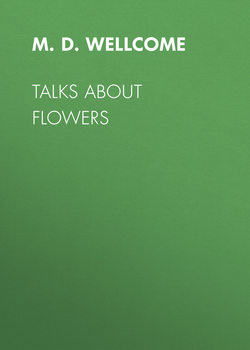Читать книгу Talks About Flowers - M. D. Wellcome - Страница 8
The Phlox Drummondii
PETUNIAS
ОглавлениеFew things in the garden will make more show throughout the entire season, even after quite severe frosts, than a bed of Petunias from a paper of seed marked "Choicest Mixed from Show Flowers." They will produce such a profusion of flowers, charming one from day to day with their variations of markings, and of color. Some retain their distinctive characteristics, while with others they are changeful as the Kaleidoscope. Stripes, blotches, sprays, white throats, green edges, they are just lovely. Then there are the double sorts; purple with white spots, white with purple; rose color, white, purplish-crimson margined with white; lilac veined with purple; white with stripes of purple in the center of each petal, some exquisitely fringed; large and full as a rose, and some almost as sweet.
In nothing, perhaps, has there been such a wonderful improvement by culture and hybridising as the Petunia. Mr. Vick tells us how that half a century ago, he saw for the first time, a Petunia. It was a novelty—a strange flower from a flowery land, South America, and it was carefully treated in green-houses. The flower was white and small, and looked somewhat as if made of paper—such a flower as would now be destroyed if by chance seen growing accidentally in our gardens. The novelty soon subsided, and although it was ascertained that it could be grown in gardens, it did not possess sufficient merit to gain popular favor. A little later, however, about 1831, to the astonishment of the floral world, it was announced that a new Petunia, of a purple color, had been discovered in Buenos Ayres. It was first flowered and seeded in the Botanic Gardens of Glasgow, and thence seed was sent all over Europe and to America, where it soon became a great favorite. About thirty years ago a double Petunia was grown and propagated by cuttings. It was only semi-double and white, but it was the commencement of a new era in Petunia culture. Truly wonderful have been the advances in development of this beautiful flower.
The Petunia is divided into three distinct classes, the Grandiflora, Small Flowered and Double.
The Grandiflora varieties have a strong succulent growth, the flowers are not so numerous as some others, but are very large and double, frequently measuring three inches in diameter, and some kinds are exquisitely marked with various shades of violet, purple, maroon and scarlet upon white ground; some striped, others bordered, some marbled, some deeply fringed. The double Petunia gives no seed, and it is only by fertilizing single flowers with the pollen of the double that seed can be obtained. But Petunias of all kinds are easily multiplied by cuttings.
The Small Flowered class are those that make our gardens so attractive with their varied hues and markings. Some of the new hybrids are of wonderful beauty. Last year gave two of the Double and Fringed sort that have been frequently noted as gems of the first water.
Mrs. Edward Roby, color, a glowing crimson-maroon, edged with pure white, very double and deeply fringed. Model of Perfection, deep maroon, heavily edged with white, and deeply fringed. These were priced last year in a Western catalogue at $1.50 each; this year they are priced at 30 cents. So one gains by waiting a year for high-priced novelties.
New Double Fringed Petunia for 1881, is President Garfield, which originated with Mr. C. E. Allen, and is thus described in his catalogue: "Color, light purple veined with deep purple magenta, edged with a broad band of an exquisite shade of green. Very novel in its appearance and a new color in double petunias; flower very large and deeply fringed. Plants strong and vigorous; one of the finest sorts ever offered." For a Petunia so unique as this, with its broad band of green, and now offered for the first time; its price, 75 cents, is low.
Pansies
"Open your eyes, my Pansies sweet,
Open your eyes for me,
Driving away with face so true,
The chilling wind and wintry hue,
That lingers so drearily.
"Open your eyes, my Pansies sweet,
Open your eyes for me.
Where did you get that purple hue?
Did a cloudlet smile as you came through?
Did a little sunbeam bold
Kiss on your lips that tint of gold?
Tell me the mystery.
"In your eyes a story I read—
A story of constancy.
After the storms and winter's wind,
Softly you come with influence kind;
Then as I bend with listening ear,
Your cheerful voice I plainly hear,
Preaching a sermon to me.
"So, whisper to me, my Pansies sweet—
Tell me in rustlings low,
Of that beautiful land where fadeless flowers
Brightly bloom in immortal bowers,
And no blighting wind doth blow.
"Tell of the care that is over all—
That gives you your garments gay;
Whose loving hand clothes the floweret small
That grows in the field, or by the garden wall,
Whose life is only a day.
"Yes, tell of the love, my Pansies sweet,
Of the love that knows no end;
That through earth's winter safely keeps
Watch over his children, and never sleeps;
The love that paints the violet blue,
And quenches your thirst with drops of dew,
The weary heart's faithful friend."
